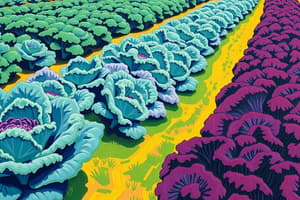Podcast
Questions and Answers
What are cover crops primarily grown for?
What are cover crops primarily grown for?
- Soil coverage (correct)
- Harvest
- Weed control
- Pest management
How do cover crops prevent soil erosion?
How do cover crops prevent soil erosion?
- By improving soil pH
- By increasing rainfall
- By reducing water velocity (correct)
- By increasing weed biomass
What are green manure cover crops primarily used for?
What are green manure cover crops primarily used for?
- Managing soil nutrients (correct)
- Increasing soil organic matter
- Pest management
- Weed control
What is the benefit of leguminous cover crops?
What is the benefit of leguminous cover crops?
How do cover crops improve soil quality?
How do cover crops improve soil quality?
What is the benefit of cover crops in reducing water runoff?
What is the benefit of cover crops in reducing water runoff?
How do cover crops compete with weeds?
How do cover crops compete with weeds?
What is the benefit of cover crops in breaking disease cycles?
What is the benefit of cover crops in breaking disease cycles?
What is the primary benefit of using cover crops as trap crops?
What is the primary benefit of using cover crops as trap crops?
Flashcards are hidden until you start studying
Study Notes
Cover Crops in Agriculture
- Cover crops are plants grown to cover soil rather than for harvest, used to manage soil erosion, fertility, quality, water, weeds, pests, diseases, biodiversity and wildlife in an agroecosystem.
- Cover crops prevent soil erosion by improving soil structure, increasing infiltration, protecting the soil surface, scattering raindrop energy and reducing the velocity of water movements.
- Green manure cover crops are used to manage soil macronutrients and micronutrients, particularly nitrogen, which is often limiting in crop production.
- Leguminous cover crops are high in nitrogen and can provide the required quantity for crop production, through biological nitrogen fixation.
- Cover crops improve soil quality by increasing soil organic matter levels, enhancing soil structure, water and nutrient holding capacity, and carbon sequestration.
- Cover crops reduce water runoff and increase soil moisture, which can improve water infiltration, soil water storage, and the recharging of aquifers.
- Cover crops compete well with weeds, reducing weed seed germination rates and biomass, and can suppress weeds through allelopathy.
- Cover crops can break disease cycles and reduce populations of bacterial and fungal diseases and parasitic nematodes.
- Some cover crops are used as trap crops to attract pests away from the crop of value and toward a more favorable habitat, while others attract natural predators of pests.
- Cover crops increase plant diversity and improve farm habitat for wildlife, supporting a higher level of wildlife diversity.
- Cover crop practices in agriculture are cost-effective, with cover cropping in the United States costing up to $35 per acre.
- Cover crops play a vital role in sustainable agriculture, reducing environmental impacts associated with chemical nitrogen fertilizer use, and maintaining or increasing future food production levels.
Studying That Suits You
Use AI to generate personalized quizzes and flashcards to suit your learning preferences.




